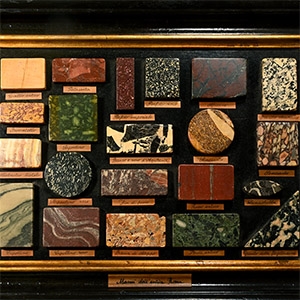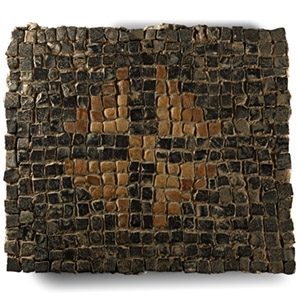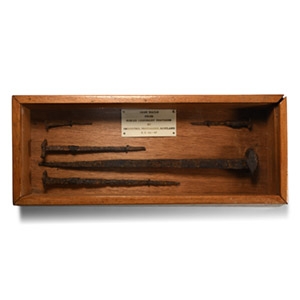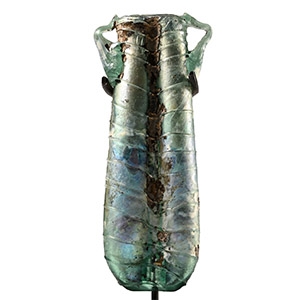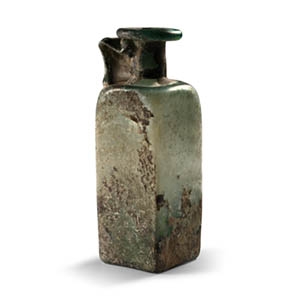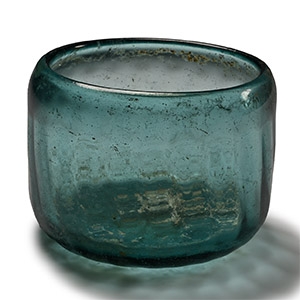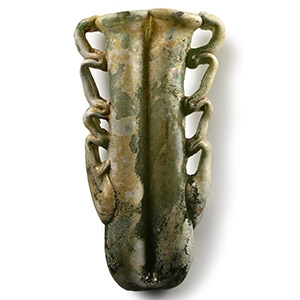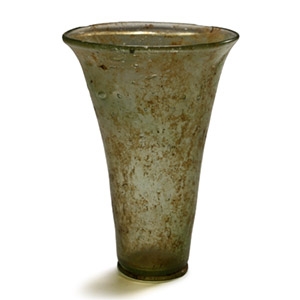Home > Auctions > 4 - 9 March 2025
Ancient Art, Antiquities, Books, Natural History & Coins
From a 19th century European collection, Paris, France.
This lot is accompanied by an illustrated lot declaration signed by the Head of the Antiquities Department, Dr Raffaele D’Amato.
Found Tunisia, North Africa.
Brought to the UK before 1945.
From a private old collection formed in the mid 20th century.
Ian Wilkinson collection, Nottinghamshire, UK, formed since 1985.
This lot is accompanied by an illustrated lot declaration signed by the Head of the Antiquities Department, Dr Raffaele D’Amato.
From excavations started by Richmond in Perthshire, Scotland, from the 1950s, and discovered in the summer of 1960.
Selected and boxed by David Colville & Sons by 1963.
Acquired from a private Scottish collection in the early 2000s.
Ian Wilkinson collection, Nottinghamshire, UK, formed since 1985.
Accompanied by a copy of an online information sheet.
This lot is accompanied by an illustrated lot declaration signed by the Head of the Antiquities Department, Dr Raffaele D’Amato.
Cf. Mapelli, C., Nicodemi, W., Riva, R.F., Vedani, M., Gariboldi, E., ‘Nails of the Roman legionary at Inchtuthil’ in La Metallurgia Italiana, January 2009, pp.51-58; fog nails used for crucifixion Connolly, P., Living in the time of Jesus of Nazareth, Oxford, 1983, pp.50-51.
The fortress at Inchtuthil was a fortified headquarters and forward supply depot for the forces led by the Roman governor, Gnaeus Julius Agricola, when he undertook a lengthy campaign against the Caledonian tribes in the north of Britain. The campaign is mentioned in the biographical work written by his son-in-law, the historian Tacitus, which has been studied in order to understand the Roman plan for the subjugation of the island. The troops chosen for the campaign were drawn from the 20th Legion (Legio XX Valeria Victrix). While the construction of Inchtuthil and other strongholds took place, the troops lived in temporary encampments which were also fortified and formed a chain of defensive sites from which domination of the surrounding territory could be achieved. Subsequently once the site was abandoned late in the 1st century A.D., (around 86 A.D.) no further building took place there or in the area. Excavation in the 20th century by Sir Ian Richmond (begun in 1952) revealed a pristine site with its complete plan recoverable - unique in the Roman Empire. The defences were a broad ditch and turf wall with stone facing, with watchtowers and gatehouses. The site was thought to have been abandoned due to relocation of troops to counter an invasion from eastern Europe into the province of Dacia, although this is no longer certain. A huge quantity of iron nails (more than 875,000) was recovered from a pit in the fort as well as other ironware; the goods had been buried in order not to let them fall into the hands of the Caledonians. The excavated nails and other items were sorted and sold in small parcels, which was completed by 1963.The nails range in size from small nails between thirty-eight and seventy millimetres long, up to the massive spikes three hundred and seventy-two millimetres long. These kind of long nails were also used for crucifixions.
Acquired 1980-2015.
Ex Abelita family collection.
This lot is accompanied by an illustrated lot declaration signed by the Head of the Antiquities Department, Dr Raffaele D’Amato.
Acquired on the Parisian art market.
with Bernard Tinivella, Saint-Ouen.
Accompanied by an academic report by Dr Raffaele D’Amato.
This lot has been checked against the Interpol Database of stolen works of art and is accompanied by a search certificate number no.12464-228803.
This lot has been cleared against the Art Loss Register database, and is accompanied by an illustrated lot declaration signed by the Head of the Antiquities Department, Dr Raffaele D’Amato.
See Felletti Maj, B.M., Museo Nazionale Romano, I Ritratti, Roma, 1953; Bianchi Bandinelli, R., Roma: la fine dell’arte Antica, Milano, 1970; Scrinari, V.S.M., Sculture Romane di Aquileia, Roma,1972; similar portraits can be seen in Palazzo dei Conservatori, Roma, in Stuart Jones, H., A catalogue of the Ancient Sculptures preserved in the municipal collections of Rome, the sculptures of the Museo Capitolino, Oxford, 1912, pls.36,40,52,74 (fig.1); another one in the Hermitage Museum, Saint Petersburg, Inv. Nos. ГР-1707 / А. 29 (fig.2, from the John Lyde Browne collection).
The coiffure is known as 'Scheitelzopf hairstyle' or 'reverse plait'. The closest parallel for this hairstyle is a portrait bust in the Palazzo dei Conservatori (inv. no. 2767), which corresponds in every detail, including the various decorative curls. The same type of hairstyle, albeit with variations in the details (decorative curls and position of the hair loop), is found on a few other portraits of women that were dated to the Period of Gallienus by Marianne Bergmann. Some of the portraits in this typologically related group are likely to be private portraits. Nonetheless, the question must be raised as to whether the portrait shows a member of the imperial family. Hereby physiognomic features and especially imperial coin portraits need to be taken into account. In this context, it is important to note that both eyeballs were reworked, whereby the iris was completely erased. Furthermore, there are pick marks on the eyebrows, eyelids, nose, cheeks, mouth and chin (partly filled in modern times). If these were intentional changes made in the context of the practice of Damnatio memoriae, they would indicate that a lady from the imperial family was represented. The neck has been prepared for insertion into a sculpture.
From an important London, UK, collection, 1970-1990s.
This lot is accompanied by an illustrated lot declaration signed by the Head of the Antiquities Department, Dr Raffaele D’Amato.
Cf. Bergman, M. et al., Ancient Glass in the Carnegie Museum of Natural History, Pittsburgh, 1980, items 194-198, for similar.
From a London, UK, collection, 1990s.
This lot is accompanied by an illustrated lot declaration signed by the Head of the Antiquities Department, Dr Raffaele D’Amato.
Cf. The Metropolitan Museum, New York, accession number 2000.64, for similar.
Dr K. and W.Z., Rheinland-Pfalz, Germany; acquired 1977 on the German art market.
This lot is accompanied by an illustrated lot declaration signed by the Head of the Antiquities Department, Dr Raffaele D’Amato.
Cf. Oliver, A. Jr., Ancient Glass, In the Carnegie Museum of Natural History, Pittsburgh, 1980, p.138, no.235, for type.
Ex Martin Wunsch, New York 1980s-1990s.
Accompanied by a copy of an Art Loss Register certificate no.S00098335.
This lot is accompanied by an illustrated lot declaration signed by the Head of the Antiquities Department, Dr Raffaele D’Amato.
Cf. Whitehouse, D., Roman Glass in The Corning Museum Of Glass, Volume One, New York, 1997, pp.261-265, for type.
Private collection, Luxembourg, 2002.
Swiss private collection, 2003.
Ex Vittorio Rizzi, Basel, prior 2005.
Accompanied by a copy of an Art Loss Register certificate no.S00035605.
This lot is accompanied by an illustrated lot declaration signed by the Head of the Antiquities Department, Dr Raffaele D’Amato.
Cf. Whitehouse, D., Roman Glass in the Corning Museum of Glass, vol.2, New York, 2001, item 772.
Ex North American collection, 1990s.
This lot is accompanied by an illustrated lot declaration signed by the Head of the Antiquities Department, Dr Raffaele D’Amato.
Cf. Whitehouse, D., Roman Glass in the Corning Museum of Glass, vol.2, New York, 2001, item 743, for type.
From an important glass collection, London, UK, 1980-1990.
This lot is accompanied by an illustrated lot declaration signed by the Head of the Antiquities Department, Dr Raffaele D’Amato.
Cf. The Metropolitan Museum, accession number 29.100.80, for comparable vessel.
85 - 96 of 3546 LOTS

